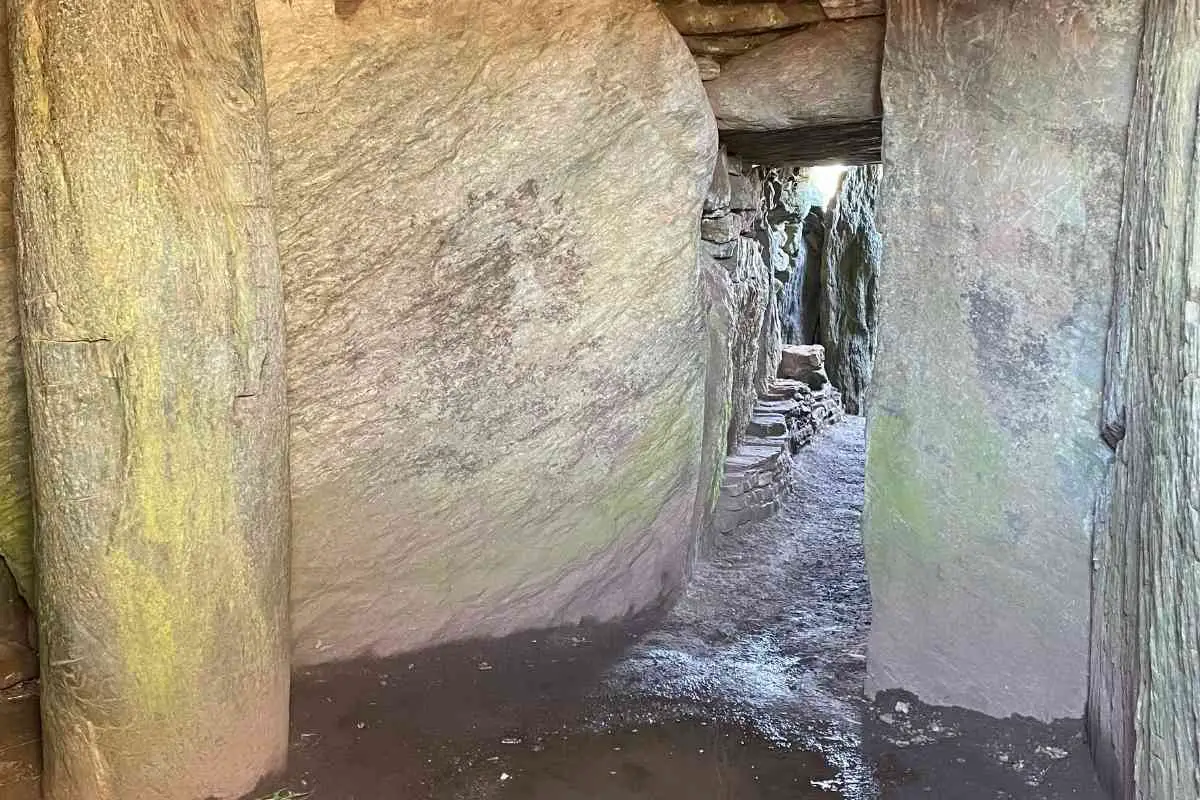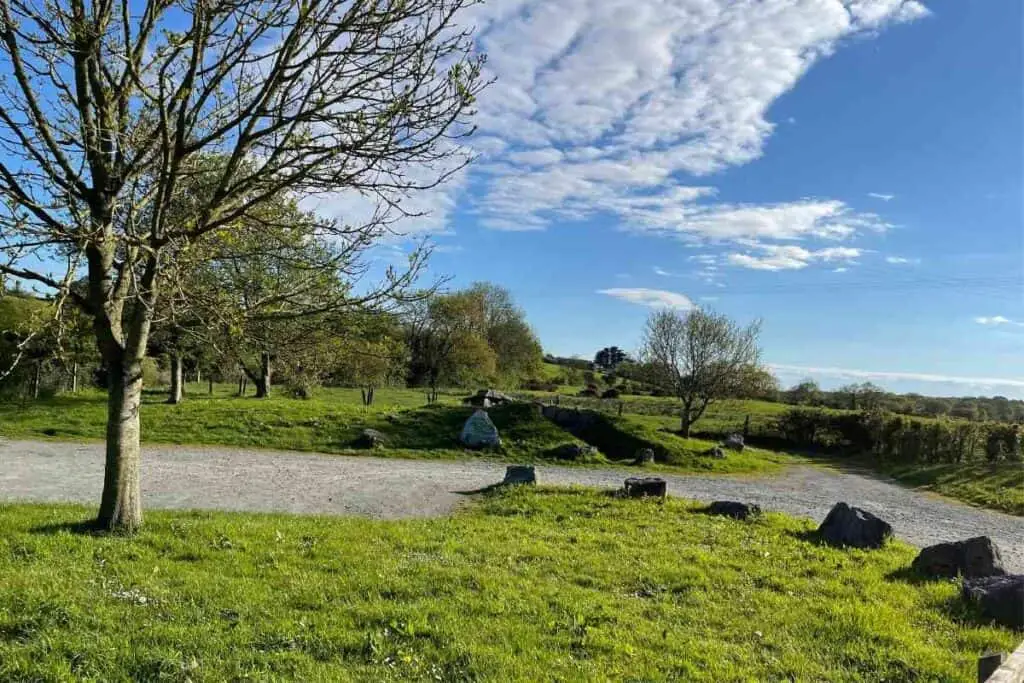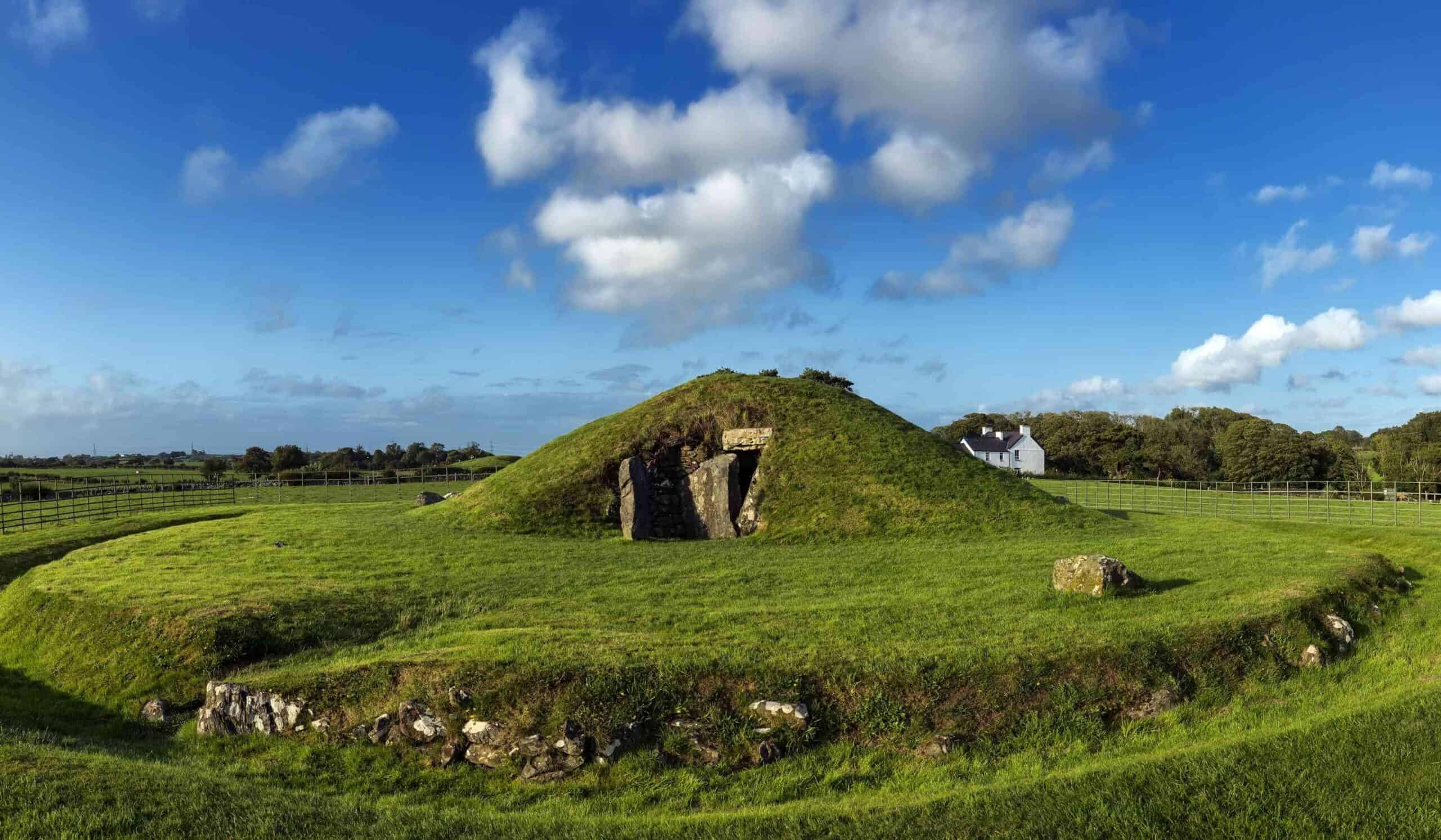Nestled on the outskirts of the small village of Llandaniel Fab is Bryn Celli Ddu, one of the Isle of Anglesey’s best-preserved burial chambers. Meaning “Mound of the Dark Grove” in English, this ancient passage tomb is one of Anglesey’s most famous prehistoric landmarks and perhaps the best burial chamber the island has to offer.
Better still, it’s open year-round and completely free to visit. So what is Bryn Celli Ddu, and why is it so fascinating?
Bryn Celli Ddu Burial Chamber History
The Bryn Celli Ddu burial chamber actually boasts a multifaceted history, with several alterations taking place during its 6000 or so years of existence, as we shall now explain.
How Old is Bryn Celli Ddu?
The earliest remains date back to around 4000 BC, denoted by five postholes, putting them at the end of the Mesolithic Period. No one is quite sure what their use was. However, things become more apparent as time progresses.

Around 1,000 years later (3,000 BC), a henge was erected, evidenced by the ditch measuring some 70ft across. In total, there was a ring of 17 stones forming an oval, many being in matched pairs on either side of the centre.
Once again, around 1,000 years after the henge was constructed radically to become the passage tomb it looks like today. Much larger than the mound now remaining, it would have had a complete circle of kerbstones following the line of the old henge ditch, creating an impressive retaining wall around the mound. The burial chamber would have been entirely enclosed within the mound, rather than the back wall being open to the air, as in the reconstructed mound now seen.
Why Was Bryn Celli Ddu Built?
The significance of the earliest versions of this site is still up for debate. As mentioned, the use for the postholes remains unknown.
However, it is thought that during the henge period of its construction, the site would have carried a significant ritual presence. Excavations have shown that a single human earbone was buried within the circle covered by a flat slab, and a second stone known as ‘The Pattern Stone’ lay nearby, with serpentine patterning on it.
You can even view a replica of the patterned stone today at the site, helping you to try and imagine what those rituals might have meant to the people at the time.
Lastly, the site acted as a burial chamber or passage tomb. Individual human bones, both burnt and unburnt, were found within the chamber and passage, suggesting various funeral practices over its centuries of use.
Why Visit Bryn Celli Ddu?
First and foremost, this site provides a fascinating insight into the lives of our ancestors. Unlike some of the other burial chambers on Anglesey, this site has not only been reconstructed to bear a close resemblance to how it did many thousands of years ago, but you can also step inside and physically touch the stones that have been in place for centuries.
You can walk the ground where human remains, arrowheads, and all sorts of other significant archaeological discoveries have been found.

Another reason to visit is a magical event that happens for a few days during late June. On an around the summer solstice, shafts of light shine directly down the tomb’s passageway to light up the tomb from within.
This extraordinary event attracts druids from all over the globe to witness the magical event each June, so you won’t be alone if you want to experience it in person.
If you are inspired to visit based on the history and intrigue of this site alone, the site is also free to visit year-round, making it an excellent value pit-stop whilst on the way to another one of Anglesey’s historical attractions, such as Aberlleiniog Castle.
Getting to Bryn Celli Ddu
Bryn Celli Ddu is only accessible via a meandering footpath that leads from the adjacent road. There is a dedicated car park on said quiet country road, which leads from the A4080 close to Plas Newydd house through to the nearby village of Llandaniel Fab. As you make your way from the A4080 towards Llandaniel Fab, the car park is on your left.
The postcode for parking is LL61 6EQ. However, be warned that this postcode is not exactly where the car park is. However, it should put you on the correct quiet country lane mentioned above.
Parking for Bryn Celli Ddu
The car park for Bryn Celli Ddu is of a decent size, with parking for around 6-7 vehicles. There is an information board there that will tell you more about the site and another replica stone circle. You can extend your stay by having a picnic on the grassy bank or within the stone circle.

Bryn Celli Ddu Walk
From the car park, cross back over the road and walk towards the A4080 until you see the sign on your left and a wooden ramp leading down to the footpath.

Follow the footpath along the river until you come to a bridge.
Cross the bridge onto the other side of the river and continue to follow the hedge-rowed path as it bends left. Walk up the path (ignore the farmer’s gates around halfway up) until you reach the right-hand turn. As you make the turn right, you’ll notice the path opening up into the field containing Bryn Celli Ddu.
Bryn Celli Ddu FAQs
How Long Should I Spend At Bryn Celli Ddu Burial Chamber?
You can spend as much time as you want at this site as there are no opening hours, and it’s free to the public year-round. Once you’ve arrived at the site, it will likely take you no longer than 30 minutes to read the information boards, spend time in and around the passage tomb, and take any photos you may want to. The walk to and from the road is also only around 5 minutes.
Thus, this site is excellent as a pit-stop visit rather than being the focus of a day touring Anglesey. You can, of course, have a picnic within the grounds of the car park, making this an excellent lunchtime excursion.
After you’ve concluded your visit here, you can head back to the A4080 and continue heading West to visit other sites of interest, such as the Anglesey Model Village, the Rhuddgear Stepping Stones, or Newborough Beach.
How Much Does it Cost to Enter Bryn Celli Ddu?
This site costs nothing to access.
When is the Best Time to Visit Bryn Celli Ddu?
Since this site is usually open all year round, there is no specific time that is better than another. However, it is worth mentioning that the site gets busy in and around the Summer Solstice due to its significance to druids.
You will find that even on sunny days in summer, the site is relatively quiet throughout the day. However, if you want to increase the chances of having the place to yourself, it’s perhaps best to visit earlier in the morning or later in the afternoon or evening.
In winter, the path to the burial chamber can become very muddy, so that’s something else to factor into your decision.
Does Bryn Celli Ddu Have Toilets?
No, there are no facilities at either the car park or the site itself.
Is Bryn Celli Ddu Pushchair-Friendly?
While it is certainly possible to get a pram to the site thanks to the ramp down from the road, it’s not particularly easy. The path is very narrow, making it challenging to fit a pushchair or wheelchair. If you have small children, it is recommended to leave the pushchair and carry them the small distance instead.
Is Bryn Celli Ddu Accessible?
While it is technically possible to access the site with a wheelchair, Bryn Celli Ddu is not wheelchair-friendly. The path to the site is very narrow and muddy in the autumn and winter months. While there are no stairs to speak of, the rough terrain and difficulties presented by the path make it difficult for disabled individuals to access, but not impossible, especially if your have a motorised mobility scooter with all-terrain capabilities.
Is Bryn Celli Ddu Dog-Friendly?
Yes, you can bring your dog to visit the site. However, please note that dogs should be kept on a lead at all times as the path and site neighbour farmland with grazing livestock. You can continue to walk by heading straight on at the bridge crossing, should you want to elongate the walk for your furry friend.
Who Owns Bryn Celli Ddu?
Bryn Celli Ddu is in the care of Cadw. Cadw is the historic environment service of the Welsh Government and forms part of the Tourism and Culture group.

